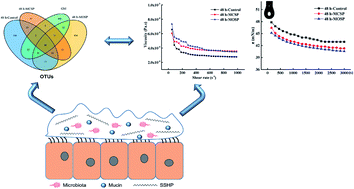Our official English website, www.x-mol.net, welcomes your
feedback! (Note: you will need to create a separate account there.)
The influence of gut microbiota on the rheological characterization of soy hull polysaccharide and mucin interactions
RSC Advances ( IF 3.9 ) Pub Date : 2020-1-15 , DOI: 10.1039/c9ra09594b Lina Yang 1, 2 , Jinghang Huang 1, 2 , Mingshuo Luo 1, 2 , Ziyi Wang 1, 2 , Lijie Zhu 1, 2 , Shengnan Wang 1, 2 , Danshi Zhu 1, 2 , He Liu 1, 2
RSC Advances ( IF 3.9 ) Pub Date : 2020-1-15 , DOI: 10.1039/c9ra09594b Lina Yang 1, 2 , Jinghang Huang 1, 2 , Mingshuo Luo 1, 2 , Ziyi Wang 1, 2 , Lijie Zhu 1, 2 , Shengnan Wang 1, 2 , Danshi Zhu 1, 2 , He Liu 1, 2
Affiliation

|
Nutrients reach the body through the food delivery system, interacting with intestinal mucus and gut microbiota for effective absorption. The purpose of this study was to investigate the possible interactions between soluble soy hull polysaccharide (SSHP), gut microbiota and mucin. The digestive environment of the porcine intestinal mucus was simulated, and the changes of the SSHP–mucin mixed system were monitored by shear rheology, interface measurement, scanning electron microscopy, particle size distribution, and microbial sequencing. First, based on scanning electron microscopy and particle size distribution, it was shown that the gut microbiota undergoes glycolysis in different mucus. The apparent viscosity and viscoelastic properties of the mucus during fermentation were then determined using shear rheology. Compared with the control and microwave-assisted citric acid extraction of soy hull polysaccharide (MCSP), the viscosity of microwave-assisted oxalic acid extraction of soy hull polysaccharide (MOSP) increased significantly (p < 0.05) at 24 h, and the thixotropy of all samples increased. The adsorption properties of mucin at the air–liquid interface were analyzed by the interfacial tension technique. As the fermentation time increased, the adsorption performance of the SSHP mucus increased, the interfacial tension decreased, and the expansion modulus increased. Moreover, according to high-throughput 16S rDNA sequencing analysis, the gut microbiota community structure changed significantly after ingestion of MCSP and MOSP, and the abundances of Bifidobacteriaceae and Lactobacillaceae increased to varying degrees. In summary, polysaccharides can be used by the intestinal flora to increase the viscosity and thixotropy of the mucus system, to increase the interfacial strength, and promote the proliferation of intestinal probiotics. This study provides useful insights for the potential application of SSHP.
中文翻译:

肠道菌群对大豆壳多糖和粘蛋白相互作用流变学特征的影响
营养物质通过食物输送系统到达身体,与肠道粘液和肠道微生物群相互作用以有效吸收。本研究的目的是研究可溶性大豆壳多糖 (SSHP)、肠道微生物群和粘蛋白之间可能存在的相互作用。模拟猪肠粘液的消化环境,通过剪切流变学、界面测量、扫描电镜、粒度分布、微生物测序等方法监测SSHP-粘蛋白混合体系的变化。首先,基于扫描电子显微镜和粒度分布,表明肠道微生物群在不同粘液中经历糖酵解。然后使用剪切流变学测定发酵过程中粘液的表观粘度和粘弹性。p< 0.05) 在 24 h 时,所有样品的触变性增加。采用界面张力技术分析粘蛋白在气液界面的吸附性能。随着发酵时间的增加,SSHP粘液的吸附性能增加,界面张力降低,膨胀模量增加。此外,根据高通量 16S rDNA 测序分析,摄入 MCSP 和 MOSP 后肠道微生物群落结构发生显着变化,双歧杆菌科和乳酸杆菌科的丰度均有不同程度的增加。综上所述,多糖可被肠道菌群利用,增加粘液系统的粘度和触变性,增加界面强度,促进肠道益生菌的增殖。
更新日期:2020-01-15
中文翻译:

肠道菌群对大豆壳多糖和粘蛋白相互作用流变学特征的影响
营养物质通过食物输送系统到达身体,与肠道粘液和肠道微生物群相互作用以有效吸收。本研究的目的是研究可溶性大豆壳多糖 (SSHP)、肠道微生物群和粘蛋白之间可能存在的相互作用。模拟猪肠粘液的消化环境,通过剪切流变学、界面测量、扫描电镜、粒度分布、微生物测序等方法监测SSHP-粘蛋白混合体系的变化。首先,基于扫描电子显微镜和粒度分布,表明肠道微生物群在不同粘液中经历糖酵解。然后使用剪切流变学测定发酵过程中粘液的表观粘度和粘弹性。p< 0.05) 在 24 h 时,所有样品的触变性增加。采用界面张力技术分析粘蛋白在气液界面的吸附性能。随着发酵时间的增加,SSHP粘液的吸附性能增加,界面张力降低,膨胀模量增加。此外,根据高通量 16S rDNA 测序分析,摄入 MCSP 和 MOSP 后肠道微生物群落结构发生显着变化,双歧杆菌科和乳酸杆菌科的丰度均有不同程度的增加。综上所述,多糖可被肠道菌群利用,增加粘液系统的粘度和触变性,增加界面强度,促进肠道益生菌的增殖。










































 京公网安备 11010802027423号
京公网安备 11010802027423号